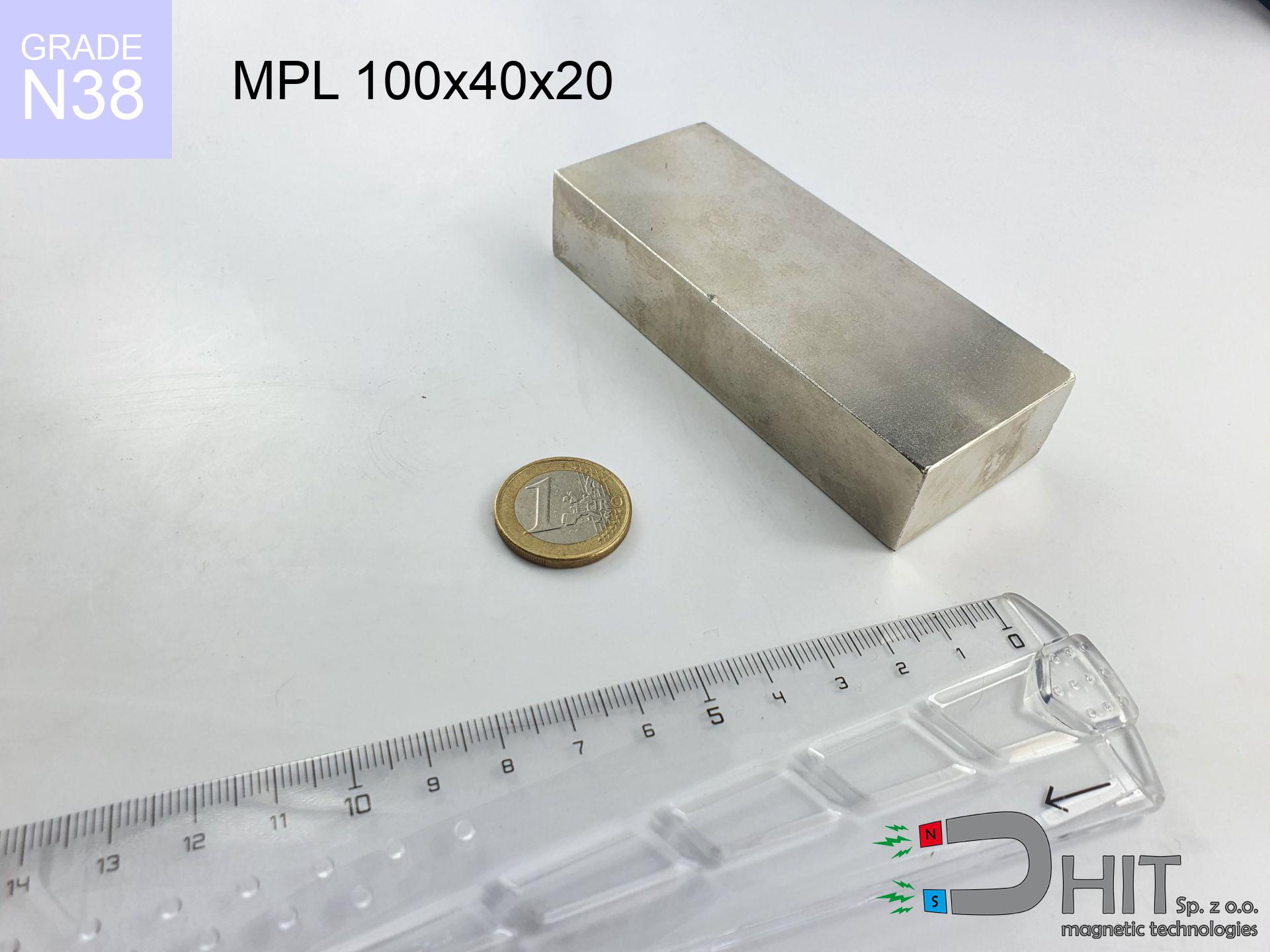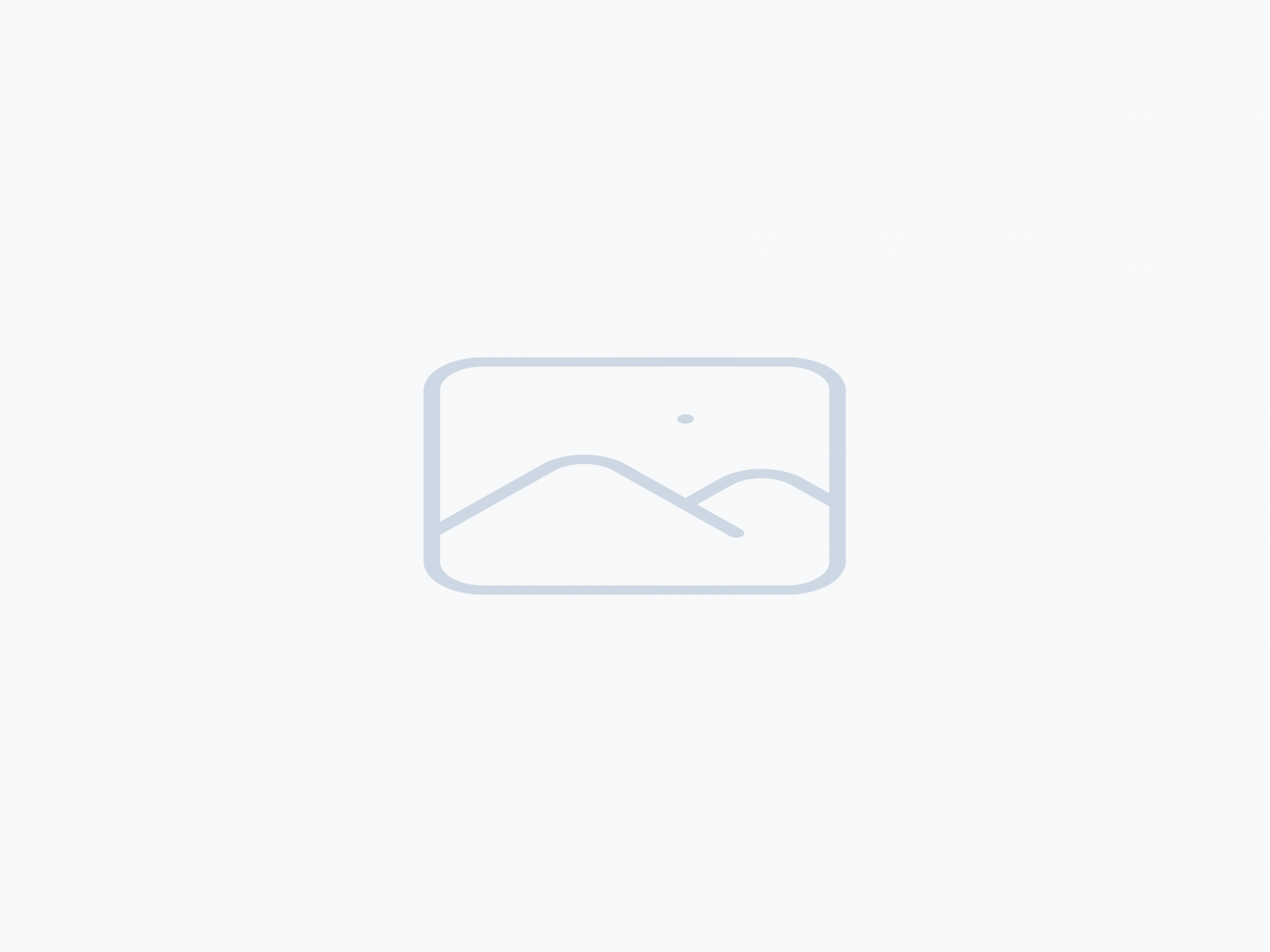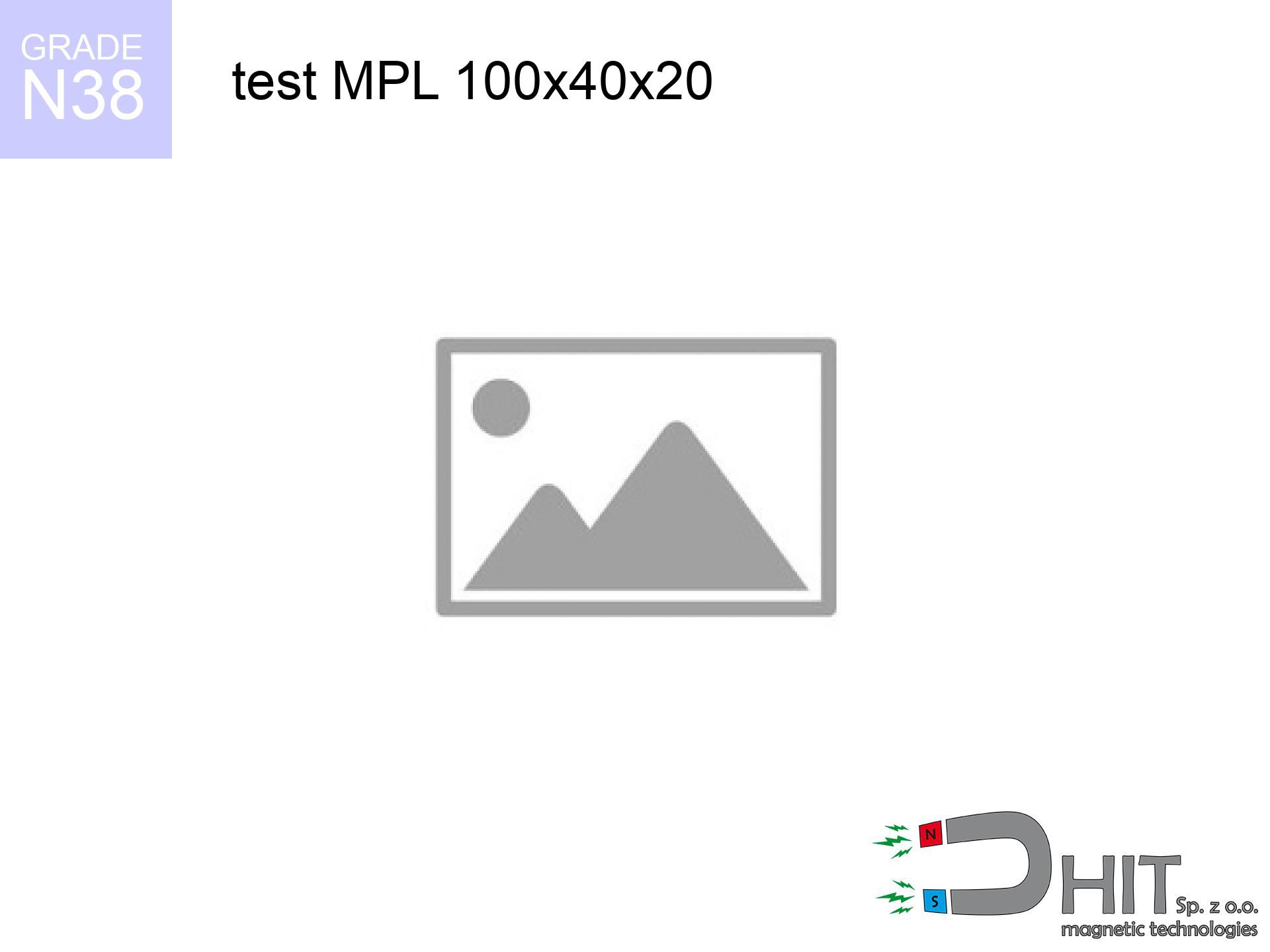MPL 100x40x20 / N38 - lamellar magnet
lamellar magnet
Catalog no 020109
GTIN/EAN: 5906301811152
length
100 mm [±0,1 mm]
Width
40 mm [±0,1 mm]
Height
20 mm [±0,1 mm]
Weight
600 g
Magnetization Direction
↑ axial
Load capacity
120.01 kg / 1177.33 N
Magnetic Induction
337.24 mT / 3372 Gs
Coating
[NiCuNi] Nickel
335.30 ZŁ with VAT / pcs + price for transport
272.60 ZŁ net + 23% VAT / pcs
bulk discounts:
Need more?Looking for a better price?
Call us now
+48 22 499 98 98
otherwise get in touch by means of
inquiry form
our website.
Specifications along with appearance of a magnet can be tested with our
modular calculator.
Same-day shipping for orders placed before 14:00.
MPL 100x40x20 / N38 - lamellar magnet
Specification / characteristics MPL 100x40x20 / N38 - lamellar magnet
| properties | values |
|---|---|
| Cat. no. | 020109 |
| GTIN/EAN | 5906301811152 |
| Production/Distribution | Dhit sp. z o.o. |
| Country of origin | Poland / China / Germany |
| Customs code | 85059029 |
| length | 100 mm [±0,1 mm] |
| Width | 40 mm [±0,1 mm] |
| Height | 20 mm [±0,1 mm] |
| Weight | 600 g |
| Magnetization Direction | ↑ axial |
| Load capacity ~ ? | 120.01 kg / 1177.33 N |
| Magnetic Induction ~ ? | 337.24 mT / 3372 Gs |
| Coating | [NiCuNi] Nickel |
| Manufacturing Tolerance | ±0.1 mm |
Magnetic properties of material N38
| properties | values | units |
|---|---|---|
| remenance Br [min. - max.] ? | 12.2-12.6 | kGs |
| remenance Br [min. - max.] ? | 1220-1260 | mT |
| coercivity bHc ? | 10.8-11.5 | kOe |
| coercivity bHc ? | 860-915 | kA/m |
| actual internal force iHc | ≥ 12 | kOe |
| actual internal force iHc | ≥ 955 | kA/m |
| energy density [min. - max.] ? | 36-38 | BH max MGOe |
| energy density [min. - max.] ? | 287-303 | BH max KJ/m |
| max. temperature ? | ≤ 80 | °C |
Physical properties of sintered neodymium magnets Nd2Fe14B at 20°C
| properties | values | units |
|---|---|---|
| Vickers hardness | ≥550 | Hv |
| Density | ≥7.4 | g/cm3 |
| Curie Temperature TC | 312 - 380 | °C |
| Curie Temperature TF | 593 - 716 | °F |
| Specific resistance | 150 | μΩ⋅cm |
| Bending strength | 250 | MPa |
| Compressive strength | 1000~1100 | MPa |
| Thermal expansion parallel (∥) to orientation (M) | (3-4) x 10-6 | °C-1 |
| Thermal expansion perpendicular (⊥) to orientation (M) | -(1-3) x 10-6 | °C-1 |
| Young's modulus | 1.7 x 104 | kg/mm² |
Physical simulation of the assembly - data
These data represent the result of a engineering simulation. Results rely on models for the material Nd2Fe14B. Real-world performance might slightly differ. Please consider these data as a reference point for designers.
MPL 100x40x20 / N38
| Distance (mm) | Induction (Gauss) / mT | Pull Force (kg) | Risk Status |
|---|---|---|---|
| 0 mm |
3372 Gs
337.2 mT
|
120.01 kg / 120010.0 g
1177.3 N
|
crushing |
| 1 mm |
3268 Gs
326.8 mT
|
112.70 kg / 112695.4 g
1105.5 N
|
crushing |
| 2 mm |
3158 Gs
315.8 mT
|
105.27 kg / 105272.6 g
1032.7 N
|
crushing |
| 3 mm |
3046 Gs
304.6 mT
|
97.92 kg / 97921.3 g
960.6 N
|
crushing |
| 5 mm |
2818 Gs
281.8 mT
|
83.78 kg / 83783.3 g
821.9 N
|
crushing |
| 10 mm |
2266 Gs
226.6 mT
|
54.17 kg / 54174.5 g
531.5 N
|
crushing |
| 15 mm |
1794 Gs
179.4 mT
|
33.96 kg / 33955.7 g
333.1 N
|
crushing |
| 20 mm |
1419 Gs
141.9 mT
|
21.25 kg / 21248.1 g
208.4 N
|
crushing |
| 30 mm |
908 Gs
90.8 mT
|
8.70 kg / 8696.3 g
85.3 N
|
strong |
| 50 mm |
416 Gs
41.6 mT
|
1.83 kg / 1825.4 g
17.9 N
|
safe |
MPL 100x40x20 / N38
| Distance (mm) | Friction coefficient | Pull Force (kg) |
|---|---|---|
| 0 mm | Stal (~0.2) |
24.00 kg / 24002.0 g
235.5 N
|
| 1 mm | Stal (~0.2) |
22.54 kg / 22540.0 g
221.1 N
|
| 2 mm | Stal (~0.2) |
21.05 kg / 21054.0 g
206.5 N
|
| 3 mm | Stal (~0.2) |
19.58 kg / 19584.0 g
192.1 N
|
| 5 mm | Stal (~0.2) |
16.76 kg / 16756.0 g
164.4 N
|
| 10 mm | Stal (~0.2) |
10.83 kg / 10834.0 g
106.3 N
|
| 15 mm | Stal (~0.2) |
6.79 kg / 6792.0 g
66.6 N
|
| 20 mm | Stal (~0.2) |
4.25 kg / 4250.0 g
41.7 N
|
| 30 mm | Stal (~0.2) |
1.74 kg / 1740.0 g
17.1 N
|
| 50 mm | Stal (~0.2) |
0.37 kg / 366.0 g
3.6 N
|
MPL 100x40x20 / N38
| Surface type | Friction coefficient / % Mocy | Max load (kg) |
|---|---|---|
| Raw steel |
µ = 0.3
30% Nominalnej Siły
|
36.00 kg / 36003.0 g
353.2 N
|
| Painted steel (standard) |
µ = 0.2
20% Nominalnej Siły
|
24.00 kg / 24002.0 g
235.5 N
|
| Oily/slippery steel |
µ = 0.1
10% Nominalnej Siły
|
12.00 kg / 12001.0 g
117.7 N
|
| Magnet with anti-slip rubber |
µ = 0.5
50% Nominalnej Siły
|
60.01 kg / 60005.0 g
588.6 N
|
MPL 100x40x20 / N38
| Steel thickness (mm) | % power | Real pull force (kg) |
|---|---|---|
| 0.5 mm |
|
4.00 kg / 4000.3 g
39.2 N
|
| 1 mm |
|
10.00 kg / 10000.8 g
98.1 N
|
| 2 mm |
|
20.00 kg / 20001.7 g
196.2 N
|
| 5 mm |
|
50.00 kg / 50004.2 g
490.5 N
|
| 10 mm |
|
100.01 kg / 100008.3 g
981.1 N
|
MPL 100x40x20 / N38
| Ambient temp. (°C) | Power loss | Remaining pull | Status |
|---|---|---|---|
| 20 °C | 0.0% |
120.01 kg / 120010.0 g
1177.3 N
|
OK |
| 40 °C | -2.2% |
117.37 kg / 117369.8 g
1151.4 N
|
OK |
| 60 °C | -4.4% |
114.73 kg / 114729.6 g
1125.5 N
|
|
| 80 °C | -6.6% |
112.09 kg / 112089.3 g
1099.6 N
|
|
| 100 °C | -28.8% |
85.45 kg / 85447.1 g
838.2 N
|
MPL 100x40x20 / N38
| Gap (mm) | Attraction (kg) (N-S) | Repulsion (kg) (N-N) |
|---|---|---|
| 0 mm |
280.40 kg / 280403 g
2750.8 N
4 790 Gs
|
N/A |
| 1 mm |
271.97 kg / 271970 g
2668.0 N
6 642 Gs
|
244.77 kg / 244773 g
2401.2 N
~0 Gs
|
| 2 mm |
263.31 kg / 263312 g
2583.1 N
6 535 Gs
|
236.98 kg / 236981 g
2324.8 N
~0 Gs
|
| 3 mm |
254.63 kg / 254635 g
2498.0 N
6 427 Gs
|
229.17 kg / 229171 g
2248.2 N
~0 Gs
|
| 5 mm |
237.35 kg / 237346 g
2328.4 N
6 205 Gs
|
213.61 kg / 213611 g
2095.5 N
~0 Gs
|
| 10 mm |
195.76 kg / 195759 g
1920.4 N
5 635 Gs
|
176.18 kg / 176183 g
1728.4 N
~0 Gs
|
| 20 mm |
126.58 kg / 126579 g
1241.7 N
4 531 Gs
|
113.92 kg / 113921 g
1117.6 N
~0 Gs
|
| 50 mm |
31.47 kg / 31470 g
308.7 N
2 259 Gs
|
28.32 kg / 28323 g
277.8 N
~0 Gs
|
MPL 100x40x20 / N38
| Object / Device | Limit (Gauss) / mT | Safe distance |
|---|---|---|
| Pacemaker | 5 Gs (0.5 mT) | 30.5 cm |
| Hearing aid | 10 Gs (1.0 mT) | 24.0 cm |
| Timepiece | 20 Gs (2.0 mT) | 18.5 cm |
| Mobile device | 40 Gs (4.0 mT) | 14.5 cm |
| Remote | 50 Gs (5.0 mT) | 13.5 cm |
| Payment card | 400 Gs (40.0 mT) | 5.5 cm |
| HDD hard drive | 600 Gs (60.0 mT) | 4.5 cm |
MPL 100x40x20 / N38
| Start from (mm) | Speed (km/h) | Energy (J) | Predicted outcome |
|---|---|---|---|
| 10 mm |
17.84 km/h
(4.96 m/s)
|
7.37 J | |
| 30 mm |
25.80 km/h
(7.17 m/s)
|
15.41 J | |
| 50 mm |
32.20 km/h
(8.94 m/s)
|
23.99 J | |
| 100 mm |
45.13 km/h
(12.54 m/s)
|
47.14 J |
MPL 100x40x20 / N38
| Technical parameter | Value / Description |
|---|---|
| Coating type | [NiCuNi] Nickel |
| Layer structure | Nickel - Copper - Nickel |
| Layer thickness | 10-20 µm |
| Salt spray test (SST) ? | 24 h |
| Recommended environment | Indoors only (dry) |
MPL 100x40x20 / N38
| Parameter | Value | SI Unit / Description |
|---|---|---|
| Magnetic Flux | 131 922 Mx | 1319.2 µWb |
| Pc Coefficient | 0.38 | Low (Flat) |
MPL 100x40x20 / N38
| Environment | Effective steel pull | Effect |
|---|---|---|
| Air (land) | 120.01 kg | Standard |
| Water (riverbed) |
137.41 kg
(+17.40 kg Buoyancy gain)
|
+14.5% |
1. Sliding resistance
*Note: On a vertical wall, the magnet holds only ~20% of its max power.
2. Efficiency vs thickness
*Thin metal sheet (e.g. 0.5mm PC case) drastically weakens the holding force.
3. Heat tolerance
*For N38 material, the safety limit is 80°C.
4. Demagnetization curve and operating point (B-H)
chart generated for the permeance coefficient Pc (Permeance Coefficient) = 0.38
The chart above illustrates the magnetic characteristics of the material within the second quadrant of the hysteresis loop. The solid red line represents the demagnetization curve (material potential), while the dashed blue line is the load line based on the magnet's geometry. The Pc (Permeance Coefficient), also known as the load line slope, is a dimensionless value that describes the relationship between the magnet's shape and its magnetic stability. The intersection of these two lines (the black dot) is the operating point — it determines the actual magnetic flux density generated by the magnet in this specific configuration. A higher Pc value means the magnet is more 'slender' (tall relative to its area), resulting in a higher operating point and better resistance to irreversible demagnetization caused by external fields or temperature. A value of 0.42 is relatively low (typical for flat magnets), meaning the operating point is closer to the 'knee' of the curve — caution is advised when operating at temperatures near the maximum limit to avoid strength loss.
Chemical composition
| iron (Fe) | 64% – 68% |
| neodymium (Nd) | 29% – 32% |
| boron (B) | 1.1% – 1.2% |
| dysprosium (Dy) | 0.5% – 2.0% |
| coating (Ni-Cu-Ni) | < 0.05% |
Ecology and recycling (GPSR)
| recyclability (EoL) | 100% |
| recycled raw materials | ~10% (pre-cons) |
| carbon footprint | low / zredukowany |
| waste code (EWC) | 16 02 16 |
View more offers
Pros as well as cons of Nd2Fe14B magnets.
Strengths
- Their strength is maintained, and after around ten years it drops only by ~1% (according to research),
- They show high resistance to demagnetization induced by external magnetic fields,
- By covering with a decorative layer of gold, the element presents an elegant look,
- They show high magnetic induction at the operating surface, which increases their power,
- Neodymium magnets are characterized by extremely high magnetic induction on the magnet surface and can function (depending on the form) even at a temperature of 230°C or more...
- Possibility of custom creating and optimizing to precise conditions,
- Wide application in future technologies – they are used in computer drives, motor assemblies, precision medical tools, as well as modern systems.
- Relatively small size with high pulling force – neodymium magnets offer strong magnetic field in compact dimensions, which enables their usage in small systems
Disadvantages
- They are prone to damage upon heavy impacts. To avoid cracks, it is worth protecting magnets using a steel holder. Such protection not only shields the magnet but also improves its resistance to damage
- Neodymium magnets lose their force under the influence of heating. As soon as 80°C is exceeded, many of them start losing their power. Therefore, we recommend our special magnets marked [AH], which maintain durability even at temperatures up to 230°C
- When exposed to humidity, magnets usually rust. To use them in conditions outside, it is recommended to use protective magnets, such as magnets in rubber or plastics, which secure oxidation and corrosion.
- We recommend casing - magnetic holder, due to difficulties in producing nuts inside the magnet and complex shapes.
- Possible danger related to microscopic parts of magnets pose a threat, if swallowed, which gains importance in the context of child health protection. Additionally, small components of these products are able to disrupt the diagnostic process medical after entering the body.
- Higher cost of purchase is one of the disadvantages compared to ceramic magnets, especially in budget applications
Lifting parameters
Highest magnetic holding force – what affects it?
- using a base made of low-carbon steel, serving as a circuit closing element
- with a thickness no less than 10 mm
- characterized by even structure
- under conditions of ideal adhesion (metal-to-metal)
- during detachment in a direction vertical to the mounting surface
- at room temperature
Magnet lifting force in use – key factors
- Gap between surfaces – even a fraction of a millimeter of separation (caused e.g. by varnish or dirt) diminishes the magnet efficiency, often by half at just 0.5 mm.
- Direction of force – maximum parameter is reached only during pulling at a 90° angle. The shear force of the magnet along the plate is typically many times smaller (approx. 1/5 of the lifting capacity).
- Element thickness – to utilize 100% power, the steel must be sufficiently thick. Paper-thin metal restricts the attraction force (the magnet "punches through" it).
- Material type – ideal substrate is high-permeability steel. Cast iron may attract less.
- Smoothness – ideal contact is possible only on smooth steel. Any scratches and bumps create air cushions, weakening the magnet.
- Thermal environment – heating the magnet results in weakening of induction. It is worth remembering the maximum operating temperature for a given model.
Holding force was measured on a smooth steel plate of 20 mm thickness, when a perpendicular force was applied, in contrast under shearing force the lifting capacity is smaller. In addition, even a small distance between the magnet and the plate lowers the holding force.
Caution required
Use magnets consciously. Their huge power can surprise even experienced users. Stay alert and do not underestimate their force.
Pacemakers
Patients with a pacemaker should maintain an safe separation from magnets. The magnetism can disrupt the functioning of the life-saving device.
Metal Allergy
It is widely known that the nickel plating (standard magnet coating) is a common allergen. If your skin reacts to metals, prevent touching magnets with bare hands and choose versions in plastic housing.
Product not for children
Adult use only. Small elements can be swallowed, causing intestinal necrosis. Keep out of reach of children and animals.
Finger safety
Danger of trauma: The attraction force is so immense that it can result in blood blisters, pinching, and broken bones. Use thick gloves.
Threat to electronics
Intense magnetic fields can erase data on payment cards, hard drives, and other magnetic media. Maintain a gap of min. 10 cm.
Machining danger
Fire warning: Neodymium dust is explosive. Avoid machining magnets in home conditions as this risks ignition.
Magnet fragility
Despite metallic appearance, the material is delicate and cannot withstand shocks. Do not hit, as the magnet may crumble into hazardous fragments.
Impact on smartphones
Remember: rare earth magnets generate a field that confuses precision electronics. Maintain a safe distance from your mobile, tablet, and navigation systems.
Permanent damage
Keep cool. NdFeB magnets are sensitive to temperature. If you need resistance above 80°C, inquire about HT versions (H, SH, UH).







![SM 25x200 [2xM8] / N42 - magnetic separator SM 25x200 [2xM8] / N42 - magnetic separator](https://cdn3.dhit.pl/graphics/products/sm-25x200-2xm8-dos.jpg)



